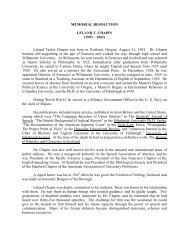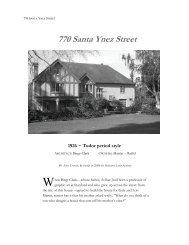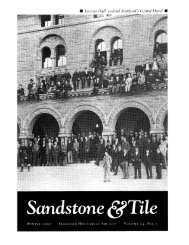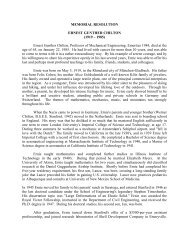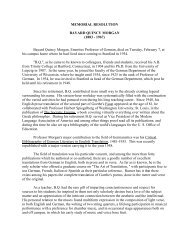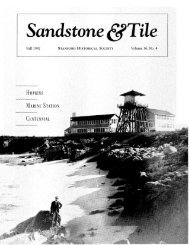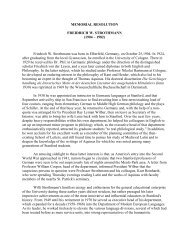memorial resolution wilhelm flügge (1904 - 1990) - Stanford ...
memorial resolution wilhelm flügge (1904 - 1990) - Stanford ...
memorial resolution wilhelm flügge (1904 - 1990) - Stanford ...
You also want an ePaper? Increase the reach of your titles
YUMPU automatically turns print PDFs into web optimized ePapers that Google loves.
MEMORIAL RESOLUTION<br />
WILHELM FLÜGGE<br />
(<strong>1904</strong> - <strong>1990</strong>)<br />
After a period of declining health, Wilhelm Flügge died at his home in Los<br />
Altos, California, on Monday, March 19, <strong>1990</strong>, one day after his 86th birthday.<br />
Wilhelm Flügge was born on March 18, <strong>1904</strong>, in Greiz, then a capital of a little<br />
principality which was later incorporated into a state of the German Republic.<br />
His father was a protestant minister who took the family to Dresden when<br />
Wilhelm was at the age of six. There he graduated from high school in 1921 and<br />
the Technical University, with the Diploma of Engineer (Dip. -Ing.) in Civil<br />
Engineering, in 1925. After serving as an assistant to Professor K. Beyer, he<br />
received the Doctor of Engineering (Dr. -Ing.) in 1927. For the next three years in<br />
Leipzig and Wiesbaden, he was involved in the development of new ideas of<br />
thin-shell construction in reinforced concrete for factories, train stations and<br />
observatories. In 1930, he accepted an appointment for post-doctoral work at the<br />
University of Göttingen, then a leading center of mathematics, engineering, and<br />
science with such prominent figures as Hilbert and Prandtl. Flügge became<br />
Privat-Dozent (comparable to an assistant professor) in 1932. He was co-founder<br />
of the journal Zentralblatt für Mechanik in 1933. A major event of the Göttingen<br />
years was the meeting of Wilhelm Flügge and Irmgard Lotz, who was a research<br />
worker in Prandtl’s group, devoted to fundamental questions of fluid dynamics.<br />
The “Lotz method” for calculating the lift on a three-dimensional wing was<br />
devised at that time, which became a standard technique used internationally.<br />
However, the position of a female in the world of science and engineering was<br />
difficult. Wilhelm has told of the secretary who served tea to the group at the<br />
weekly conference, but refused to serve Irmgard: “She can make her own tea.”<br />
In 1934 Flügge published the book for which he is widely known, Statik und<br />
Dynamik der Schalen, the first text on the theory of shell structures. Several<br />
editions have been published of the German text and of the updated English<br />
version, which first appeared in 1960 as Stresses in Shells. For almost twenty
years, this book held a unique place for engineers the world over. It served as<br />
the handbook for designers of concrete roofs, pressure vessels for storage and<br />
power generation, as well as aircraft, and served as the established point of<br />
departure for countless analytical and experimental research investigations.<br />
Even after numerous other texts on the subject have appeared, this book<br />
continues to occupy the position of primary reference. A significant portion<br />
consists of original work by Flügge which is the standard of comparison, often<br />
referred to as “classical”, for both simpler and more elaborate theories. Among<br />
his subsequent publications was the Handbook of Engineering Mechanics, 1962.<br />
Despite his technical accomplishments, shortly after the turnover in<br />
Germany in 1933, Flügge was branded as “politically unreliable” and lost all<br />
hope for a university career. Employment came in 1938, when he accepted the<br />
position of department head in the Deutschland Versuchsanstalt Luftfahrt<br />
(DVL) in Berlin, the German equivalent of NASA. Göring was more interested<br />
in competence than political and racial purity in developing the German aircraft<br />
industry. About that time, Wilhelm married Irmgard Lotz, who had been<br />
appointed head of the fluid mechanics section of DVL. In the spring of 1944, the<br />
destruction of Berlin had progressed so far that Wilhelm and Irmgard moved<br />
with their departments to Saulgau, a little town in the hills of southern<br />
Germany. After the end of the war, Saulgau was in the French zone of<br />
occupation. The French aeronautical establishment was resurrected after the<br />
war on an enlarged scale and was eager to take in the German intelligentsia. In<br />
1947 Wilhelm Flügge and Irmgard Flügge-Lotz moved with many of their coworkers<br />
to Paris, to become part of the Office National d’Études et de<br />
Recherches Aéronautiques (ONERA). Life in Paris was pleasant, but<br />
professionally with limited future. A casual letter of inquiry about the<br />
possibility of a job in the United States to Professor Stephen Timoshenko led to a<br />
quick offer of a position as Professor at <strong>Stanford</strong> University. Timoshenko<br />
deserves the credit for bringing mathematical analysis into engineering practice,<br />
certainly in the area of structures. He realized the advantage of bringing<br />
Wilhelm Flügge to strengthen the work in applied mechanics at <strong>Stanford</strong>. He<br />
was, apparently, not so interested in fluids. With the University policy that<br />
husband and wife could not hold professional rank in the same department, the<br />
consequence was that Irmgard Flügge-Lotz was only tolerated in the position of<br />
“lecturer.” The irony is that in addition to her work in fluids, she was one of the<br />
pioneers in the field of discontinuous automatic control. Nearly twenty years<br />
later as she approached retirement, she belatedly received the appointment as<br />
Professor.<br />
In their twenty years of active service at <strong>Stanford</strong> University Wilhelm<br />
Flügge and Irmgard Flügge-Lotz provided inspiration to students and col-
leagues. Some seventy Ph.D. theses were completed under their direction.<br />
Neither lost the fairly heavy accent in English, possibly because they decided<br />
when arriving in America to speak only English to each other. However, when<br />
Wilhelm would explain in a lecture how one should (conceptually) “put the<br />
fingers there on and bend”, the message of combining basic physical<br />
interpretation with mathematics was crystal clear. The Flügges did not have<br />
children, but possibly compensated by adopting, in their own formal way, all<br />
the mechanics colleagues, students, and visitors. A regular schedule of inviting<br />
people for evening tea at their home in Los Altos was maintained.<br />
Irmgard died in 1974, only a few years after her retirement, leaving Wilhelm<br />
alone for the past sixteen years. He maintained the home exactly as it was with<br />
her, occasionally inviting guests for evening tea and on rarer occasions<br />
preparing an elaborate meal for guests. The spirit of Irmgard was always<br />
present. After his retirement, Wilhelm finished the books Viscoelasticity and<br />
Tensorial Methods in Continuum Mechanics. Subsequently, he devoted his<br />
attention to his hobbies of photography, bird watching, a cactus collection, and<br />
traveling. Many will remember the unique Christmas cards he would prepare,<br />
featuring an interesting angle photograph of his latest little creation, such as a<br />
quizzical owl from a pine cone. He was originally attracted to civil engineering<br />
for the opportunity to build beautiful structures. A source of regret for his<br />
career was that so much of the effort for beautiful structures and beautiful<br />
mechanics was applied to destructive purposes.<br />
Wilhelm Flügge received many honors, including the von Kármán Medal of<br />
the American Society of Civil Engineers and the Worcester Reed Warner Medal<br />
of the American Society of Mechanical Engineers. In December, 1989, a banquet<br />
was held in San Francisco in honor of his 85th birthday, which was attended by<br />
about fifty friends and former students from all parts of the country. He<br />
delivered his typical sharp perspective on the state of the world and current<br />
engineering. It seems to be no coincidence that he died on the day after his 86th<br />
birthday. On that day his driver’s license expired and could not be renewed<br />
because of failing eyesight, as well as failing strength. He simply was not willing<br />
to yield the home he shared with Irmgard, nor his independence. His departure<br />
marks the end of an era.<br />
Wilhelm Flügge is survived by a brother Professor Siegfried Flügge of<br />
Hinterzarten, Germany, who was editor of the comprehensive Handbuch der<br />
Physik, and a niece Dr. Gertrud Farber of Chicago, Illinois. The “Wilhelm Flügge<br />
and Irmgard Flügge-Lotz Memorial Award”, for the outstanding graduate<br />
student each year, has been established in the Applied Mechanics Division of<br />
<strong>Stanford</strong> University.
James Gere<br />
George Herrmann<br />
Charles R. Steele



